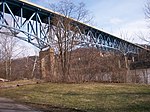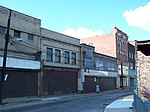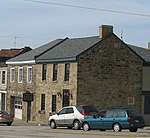Brownsville is a borough in Fayette County, Pennsylvania, United States, first settled in 1785 as the site of a trading post a few years after the defeat of the Iroquois enabled a resumption of westward migration after the Revolutionary War. The trading post soon became a tavern and inn and was receiving emigrants heading west, as it was located above the cut bank overlooking the first ford that could be reached to those descending from the Allegheny Mountains. Brownsville is located 40 miles (64 km) south of Pittsburgh along the east bank of the Monongahela River.
According to the United States Census Bureau, the borough of Brownsville has a total area of 1.1 square miles (2.8 km2), of which 0.97 square miles (2.5 km2) is land and 0.1 square miles (0.3 km2), or 10.47%, is water—most of which is the Fayette County half of the Monongahela River between the community and the flatter lands of West Brownsville on the opposite shore in Washington County. As a community, the town is the central population center for a number of outlying hamlets geographically tied to the town for the same reasons they were founded nearby: western Pennsylvania has far more hills and steep slopes than flats or gentle sloping terrains suitable for settlement. This keeps Brownsville at the nexus of the transportation infrastructure which grew up during its history. While no longer a passenger depot, Brownsville and West Brownsville share an important railway bridge, creating a balloon loop that allows the turning of complete coal trains. The limited-access toll road PA Route 43 connects the town to strategic points and southern Pittsburgh at Clairton. PA Route 88, hugging the river, connects to towns up and down the Monongahela Valley. The historic National Road (now U.S. Route 40) reached East Saint Louis, Illinois, and connected the town to the immigrants arriving in the port of Baltimore traveling west on the Cumberland Turnpike and the National Road.
From its founding, well into the 19th century, as the first reachable population center west of the Alleghenies barrier range on the Mississippi watershed, the borough quickly grew into an industrial center, market town, transportation hub, outfitting center, and riverboat-building powerhouse. As a trading post, it was a gateway destination for emigrants heading west to the Ohio Country and the new United States' Northwest Territory, and later for travelers heading westwards on the various Emigrant Trails both to the Near West and later the Far West. As an outfitting center, the borough provided the markets for the small-scale industries in the surrounding counties, as well as for Maryland shipping goods over the pass by mule train via the Cumberland Narrows toll route.
Brownsville became a major center for building steamboats through the 19th century, producing 3,000 boats by 1888.
The borough developed in the late 19th century as a railroad yard and coking center, with other industries related to the rise of steel in the Pittsburgh area. It reached a peak of population of more than 8,000 in 1940. Postwar development took place in suburbs, as was typical of the time. The restructuring of the railroad and steel industries caused a severe loss of jobs and population in Brownsville, beginning in the 1970s. The borough had a population of 2,331 as of the 2010 census.









